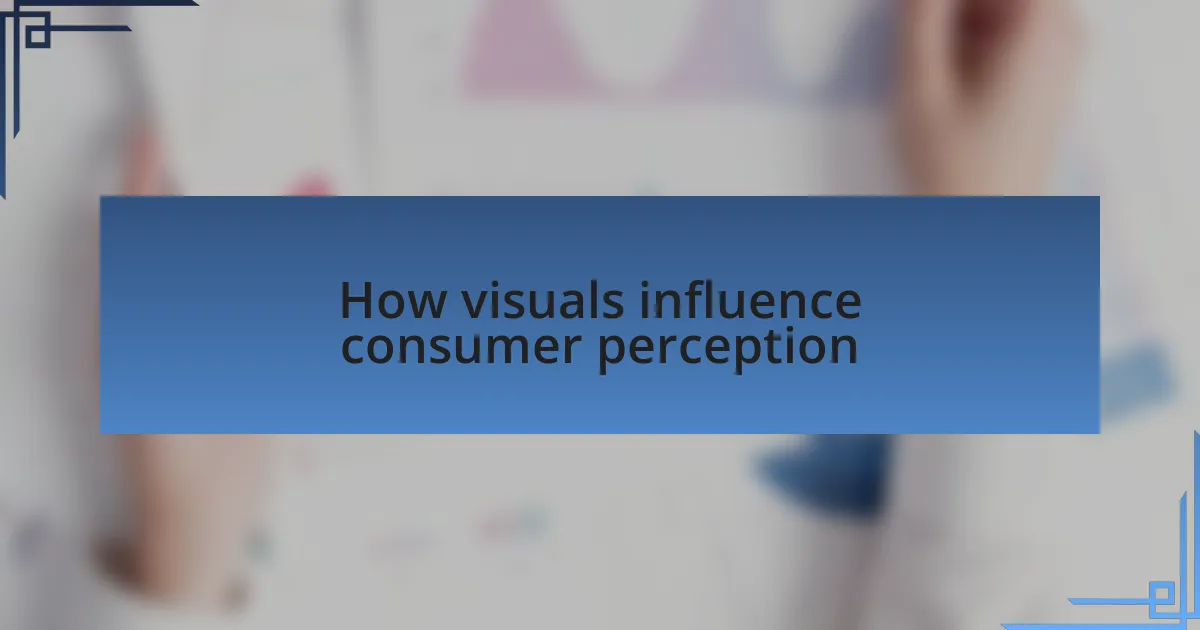Key takeaways:
- Visual branding elements, including logos, color palettes, and typography, significantly influence brand identity and consumer perception.
- Consistency in visual branding builds trust and recognition among audiences, enhancing customer experience.
- Emotional connections through visuals, such as color psychology and relatable imagery, can greatly impact consumer decisions.
- Understanding your audience and aligning visuals with messaging is crucial for effective branding; simplicity often yields better engagement.

Understanding visual branding elements
Visual branding elements are the building blocks of a brand’s identity, encompassing everything from logos to color palettes. I remember when I was developing my own brand’s website; the right shade of blue sparked a sense of trust and reliability in my audience. Isn’t it fascinating how color can evoke emotions and influence perceptions?
Logos, for instance, serve as a symbolic representation of a brand’s values and attributes. When I first encountered a simple, well-designed logo, it instantly made the brand more recognizable to me. It prompted me to think, could a logo truly encapsulate a mission or promise in such a small visual?
Typography is another critical component that often gets overlooked. The choice of font can convey elegance, playfulness, or authority—depending on the brand’s voice. Personally, I’ve found that using a clean, modern font on my site made me feel more professional, while a more whimsical font worked wonders for a community project I once led. How does your choice of typography reflect your brand’s personality?

Key components of visual branding
Visual branding encompasses several key components, each playing a vital role in how a brand is perceived. One essential aspect is the color palette. I recall an instance when I was rebranding a local café. Choosing warm, inviting colors not only transformed the café’s ambiance but also drew more customers in, creating a sense of comfort and community. Isn’t it amazing how a mere selection of colors can set the stage for customer experience?
Another crucial element is imagery, which includes everything from photographs to icons. While working on my own website, I discovered that the right images could convey messages instantly, far beyond what words could say. I remember selecting a series of candid photos of my services in action; it made the brand feel authentic and relatable. Don’t you think images tell stories that text sometimes fails to capture?
Lastly, consistency across all visual elements is vital. During a project for a non-profit, I learned that keeping visual branding cohesive—through repeated use of colors, logos, and styles—helped build trust. It struck me how familiar visuals create a sense of reliability and recognition in an audience. How consistent is your visual branding in communicating your message?

How visuals influence consumer perception
Visual elements can profoundly shape how consumers perceive a brand, often influencing their first impressions within seconds. I vividly recall analyzing a competitor’s website that used bold, energetic visuals, which immediately conveyed excitement about their services. It made me ponder—how often do we judge a brand based on the visuals alone?
The effectiveness of imagery goes beyond aesthetics. During a project with an e-commerce site, I discovered that high-quality product photos significantly increased consumer confidence. There was something magical about seeing the details up close; I realized that visuals can communicate quality and trustworthiness better than any tagline. Have you ever felt more assured about a purchase simply because of a compelling image?
Moreover, the application of color psychology can’t be overlooked. In a branding workshop, I experimented with different color schemes for a client’s website and noticed how certain shades evoked specific emotions. It dawned on me that visuals not only attract but also influence feelings, ultimately guiding decisions. Have you considered how your color choices might sway consumer emotions?

My personal experience with branding
Reflecting on my personal journey with branding, I can’t help but recall a pivotal moment when I rebranded my initial freelance business. I took a step back to rethink my logo and website visuals, feeling that the previous design didn’t represent my brand’s essence. It was through this redesign that I learned just how powerful a well-crafted image can be in establishing a deeper connection with potential clients.
Another experience that stands out is when I collaborated with a local coffee shop to elevate its brand presence. I suggested integrating a consistent visual theme across their social media and in-store materials. Seeing the transformation of their customer engagement was eye-opening; it was as if a cohesive visual identity had breathed new life into their brand. Have you ever noticed how a unified aesthetic can make a business feel more inviting?
I also remember the moment I grasped the importance of typography in branding—sending off a newsletter using a font that was difficult to read. The feedback was instant: my audience felt disconnected and disinterested. This taught me that not only do visuals attract attention, but they also play a critical role in maintaining ongoing relationships with your audience. How much do you think the right font can impact your brand’s voice?

Lessons learned from visual branding
Visual branding goes beyond aesthetics; it creates an emotional connection. I recall a time when I introduced a bold color palette to my own agency’s branding. Initially, I felt hesitant about such a dramatic change, but the feedback was overwhelmingly positive. Clients remarked that the new colors energized the brand, making it more relatable and memorable. Isn’t it fascinating how colors can evoke specific feelings?
Another lesson I learned came from a mismatch between visuals and messaging during a social media campaign. I designed vibrant images that conveyed excitement, but the accompanying text was stilted and overly formal. The inconsistency made my audience feel alienated, highlighting the need for alignment in all visual elements. How often do we overlook this crucial connection, thinking visuals alone will do the trick?
Lastly, I found that simplicity can sometimes have the most impact. When I simplified my website’s design—removing clutter and focusing on core messages—I noticed a dramatic increase in user engagement. Less truly became more, allowing users to navigate effortlessly and focus on what mattered most. Have you ever experienced such a transformative effect simply by decluttering your visual space?

Tips for effective visual branding
When it comes to effective visual branding, consistency is key. I remember a project where I used varying shades of blue for different promotional materials, thinking it would create a dynamic feel. However, I soon realized that this inconsistency left potential clients confused about our brand identity. It struck me that a cohesive color scheme not only provides clarity but also builds trust. Have you noticed how brands that stick to a consistent palette are often the ones that stick in your mind?
Another vital aspect is knowing your audience. I once designed a logo that I loved, featuring intricate details and a sophisticated font. However, feedback revealed that our target demographic found it too complex and unapproachable. The experience taught me that visuals should resonate with the audience’s preferences and expectations. How do you ensure that your branding speaks directly to the people you want to reach?
Moreover, integrating storytelling into your visuals can create a profound emotional connection. I recall a campaign where we used imagery depicting real customer experiences, which deeply engaged our audience. Sharing stories through visuals allows brands to communicate values and experiences that resonate. Have you ever been moved by an ad simply because it told a relatable story?